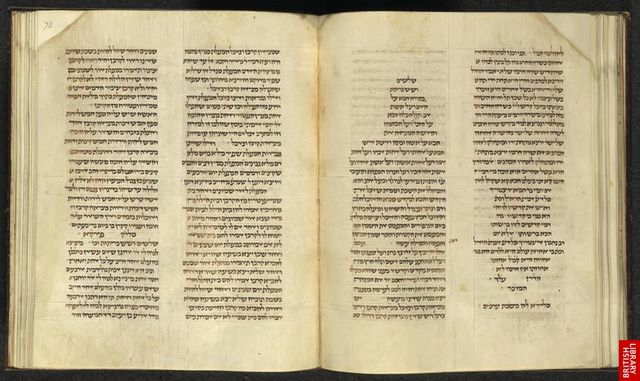 Excerpted from Lawrence H. Schiffman, From Text to Tradition, Ktav Publishing House, Hoboken, NJ, 1991.
Excerpted from Lawrence H. Schiffman, From Text to Tradition, Ktav Publishing House, Hoboken, NJ, 1991.
The Babylonian Talmud was produced by circles of Babylonian amoraim who were led in each generation by masters whose schools constituted the center of amoraic activity. Although there was some tannaitic activity there, Babylonia did not become a center of talmudic study until the time of Rav and Samuel in the first half of the third century.
The most important centers of amoraic activity were Nehardea, Sura, Pumbedita, Mahoza, Naresh, and Mata Mehasya. The amora Samuel functioned at Nehardea, and his colleague Rav is said to have founded the center at Sura. After Samuel’s death in 259 C.E., Nehardea was destroyed by Palmyrene marauders. After Rav’s death, the dominant figure at Sura was Rav Huna (d. 297). (The title “rav,” the Babylonian Jewish equivalent of rabbi, indicated that the holder had been empowered to render legal decisions.) Rav Huna was associated with several younger scholars, Rav Judah, Rav Hisda, Rav Sheshet, and Rav Nahman bar Jacob (d. 320). Rav Judah was said to have founded a circle of scholars at Pumbedita. Rabba bar Nahmani (d. 320) and Rav Joseph (d. 323) were both active in Pumbedita. Abaye carried on his school there (from 323 to 338). Rava served there from 338 to 352, and afterwards relocated to Mahoza. Historians see the Mahoza school as a continuation of that of Pumbedita. In any case, the importance of the Mahoza circle was greatly diminished by Rava’s death in 352. Papa founded a circle at Naresh
which he headed until 371, and Rav Nahman bar Isaac then took over at Pumbedita. The next generation of scholars included Rav Ashi, the preeminent figure of the age, in Mata Mehasya, near Sura. At the same time Amemar was active in Nehardea, and Rav Zevid, Rav Dimi, and Mar Zutra were the leading sages at Pumbedita. Amoraic activity continued thereafter for only one final generation, with Meremar, Rav Idi bar Abin, and Mar bar Rav Ashi in Sura. These scholars, as already mentioned, most probably did not head formal academies, but rather schools or circles of disciples organized along informal lines. From a variety of talmudic sources it is clear that the leading amoraim and their disciples also played a role in the public life of Babylonian Jewry, as homilists, judges, and teachers, seeking to spread the Judaism of the rabbinic tradition to the Babylonian Jewish masses, a goal in which they ultimately succeeded.
The Babylonian Talmud, like its Palestinian counterpart, is not complete for the entire Mishnah. For the order Zera’im there is only Berakhot. Virtually all of the orders Mo’ed, Nashim, Neziqin, and Qodashim are covered. Of Tahorot, only tractate Niddah is found. A variety of explanations is possible. Most likely, this distribution reflects the curriculum of study in Babylonia, in which agricultural laws did not apply and most of the purification rituals were no longer practiced. Sacrifice was studied to some degree, since study of its laws served as a substitute for its performance. Another view holds that all aspects of Jewish law were studied but the redactor of the Babylonian Talmud chose to include only those which were still applicable. Finally, it may be that more material existed but that some was lost to the vicissitudes of oral transmission and then of written preservation.
Various attempts have been made to sketch and compare the basic characteristics of the two Talmuds. Many of the comparisons have turned out to be exaggerated and overdrawn. At the same time, it is true that the Babylonian Talmud, because of the longer period of amoraic activity in Babylonia, abounds in detailed logical debates, whereas material of this kind is less often found in the Palestinian Talmud. The claim that the Babylonian Talmud makes less use of tannaitic tradition cannot be substantiated. Since it contains much amoraic material of Palestinian provenance (and vice versa), attempts to look for Babylonian (or Palestinian) social and economic conditions in the amoraic traditions cannot be based on the collections in their complete form. Such studies must be grounded rather on the provenance and dating of individual statements and traditions.
One definite difference between the Talmuds, however, is the use of different dialects of Aramaic. Since ancient times the Aramaic language had been divided into western and eastern dialects. The Jews of Palestine used the Galilean form of the western one, close in many ways to the Imperial Aramaic of biblical times, while those of Babylonia used the eastern, which was similar to Syriac and Mandaic. Not surprisingly, the two Talmuds reflect this pattern. Further, while they have many linguistic features in common, they often employ different technical terminology.
Medieval opinion held that the Babylonian Talmud had been redacted by Ravina I (d. ca. 420) and Rav Ashi (d. 427), who were among the last of the amoraim. While it is reasonable to credit their generation with having collected and edited the tannaitic and amoraic materials that had come down to them, often in the form of sugyot, the final redaction must have postdated these sages. In all probability the redactional process extended well into the sixth century. The final redactors, who left their mark in the anonymous (setam) layer of the Babylonian Talmud, wove together the traditions they had received with the anonymous discussions, the shaqla’ we-tarya’ (“give and take”), and added the many formulary expressions that designate the various types of material which make up the Babylonian Gemara.
